Problem Solving with the Reference of a Case Study
VerifiedAdded on 2022/11/17
|7
|1791
|138
AI Summary
Read about problem-solving with the reference of a case study of Daisy Mayers, a patient admitted to a hospital due to chest infection and bilateral lower lobe pneumonia. Learn about breached standards, priority issues, and recommendations for better healthcare services.
Contribute Materials
Your contribution can guide someone’s learning journey. Share your
documents today.
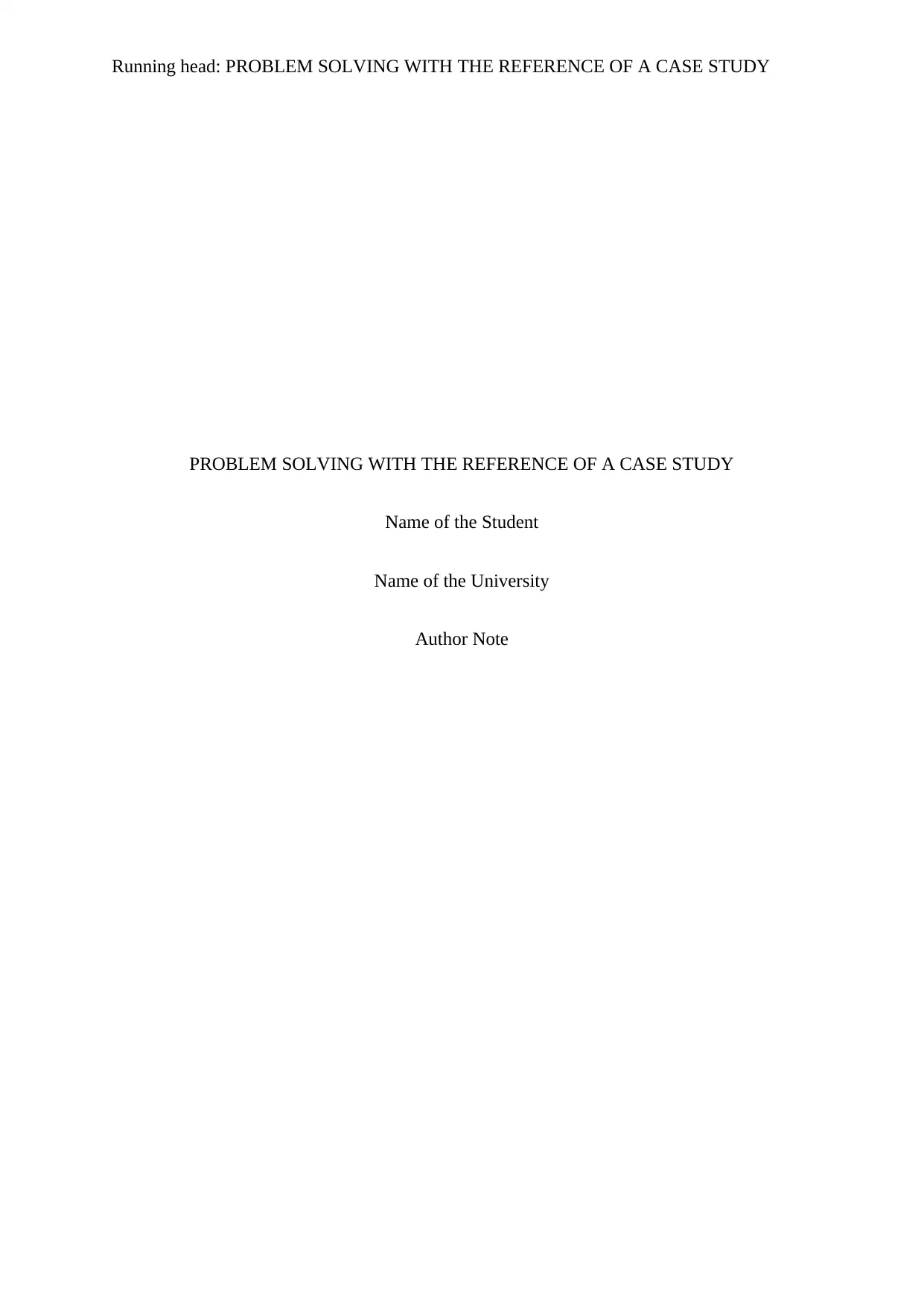
Running head: PROBLEM SOLVING WITH THE REFERENCE OF A CASE STUDY
PROBLEM SOLVING WITH THE REFERENCE OF A CASE STUDY
Name of the Student
Name of the University
Author Note
PROBLEM SOLVING WITH THE REFERENCE OF A CASE STUDY
Name of the Student
Name of the University
Author Note
Secure Best Marks with AI Grader
Need help grading? Try our AI Grader for instant feedback on your assignments.
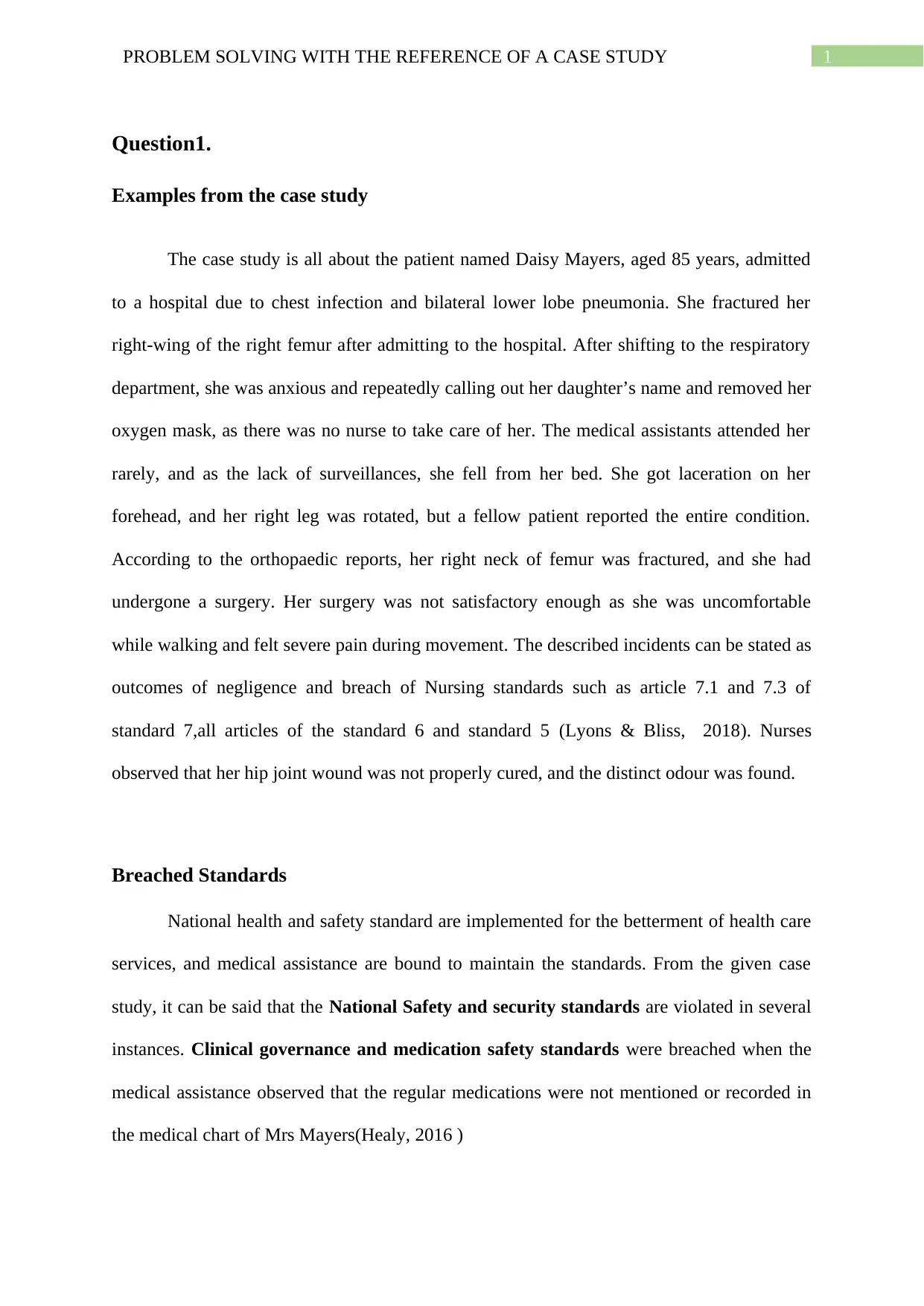
1PROBLEM SOLVING WITH THE REFERENCE OF A CASE STUDY
Question1.
Examples from the case study
The case study is all about the patient named Daisy Mayers, aged 85 years, admitted
to a hospital due to chest infection and bilateral lower lobe pneumonia. She fractured her
right-wing of the right femur after admitting to the hospital. After shifting to the respiratory
department, she was anxious and repeatedly calling out her daughter’s name and removed her
oxygen mask, as there was no nurse to take care of her. The medical assistants attended her
rarely, and as the lack of surveillances, she fell from her bed. She got laceration on her
forehead, and her right leg was rotated, but a fellow patient reported the entire condition.
According to the orthopaedic reports, her right neck of femur was fractured, and she had
undergone a surgery. Her surgery was not satisfactory enough as she was uncomfortable
while walking and felt severe pain during movement. The described incidents can be stated as
outcomes of negligence and breach of Nursing standards such as article 7.1 and 7.3 of
standard 7,all articles of the standard 6 and standard 5 (Lyons & Bliss, 2018). Nurses
observed that her hip joint wound was not properly cured, and the distinct odour was found.
Breached Standards
National health and safety standard are implemented for the betterment of health care
services, and medical assistance are bound to maintain the standards. From the given case
study, it can be said that the National Safety and security standards are violated in several
instances. Clinical governance and medication safety standards were breached when the
medical assistance observed that the regular medications were not mentioned or recorded in
the medical chart of Mrs Mayers(Healy, 2016 )
Question1.
Examples from the case study
The case study is all about the patient named Daisy Mayers, aged 85 years, admitted
to a hospital due to chest infection and bilateral lower lobe pneumonia. She fractured her
right-wing of the right femur after admitting to the hospital. After shifting to the respiratory
department, she was anxious and repeatedly calling out her daughter’s name and removed her
oxygen mask, as there was no nurse to take care of her. The medical assistants attended her
rarely, and as the lack of surveillances, she fell from her bed. She got laceration on her
forehead, and her right leg was rotated, but a fellow patient reported the entire condition.
According to the orthopaedic reports, her right neck of femur was fractured, and she had
undergone a surgery. Her surgery was not satisfactory enough as she was uncomfortable
while walking and felt severe pain during movement. The described incidents can be stated as
outcomes of negligence and breach of Nursing standards such as article 7.1 and 7.3 of
standard 7,all articles of the standard 6 and standard 5 (Lyons & Bliss, 2018). Nurses
observed that her hip joint wound was not properly cured, and the distinct odour was found.
Breached Standards
National health and safety standard are implemented for the betterment of health care
services, and medical assistance are bound to maintain the standards. From the given case
study, it can be said that the National Safety and security standards are violated in several
instances. Clinical governance and medication safety standards were breached when the
medical assistance observed that the regular medications were not mentioned or recorded in
the medical chart of Mrs Mayers(Healy, 2016 )
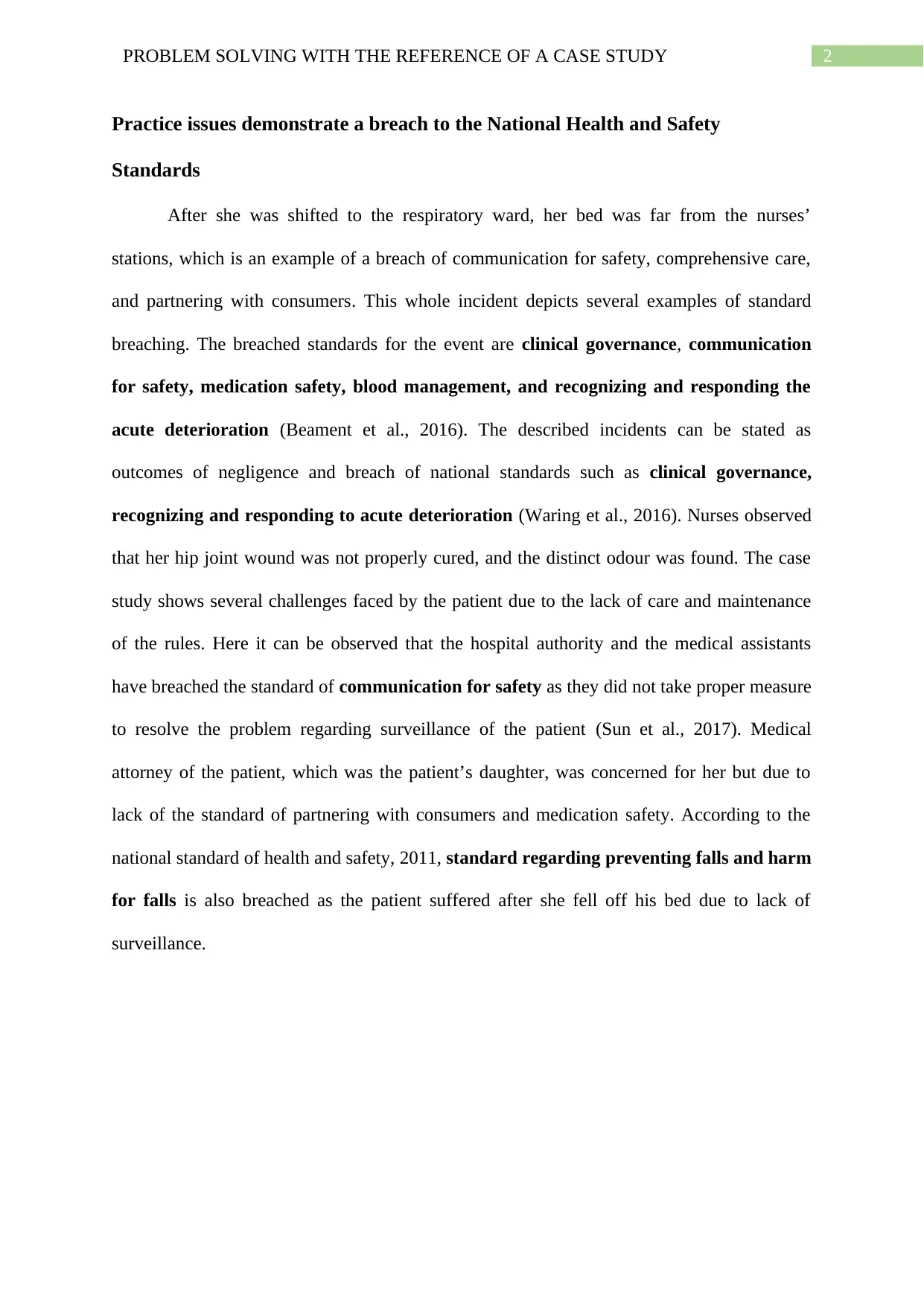
2PROBLEM SOLVING WITH THE REFERENCE OF A CASE STUDY
Practice issues demonstrate a breach to the National Health and Safety
Standards
After she was shifted to the respiratory ward, her bed was far from the nurses’
stations, which is an example of a breach of communication for safety, comprehensive care,
and partnering with consumers. This whole incident depicts several examples of standard
breaching. The breached standards for the event are clinical governance, communication
for safety, medication safety, blood management, and recognizing and responding the
acute deterioration (Beament et al., 2016). The described incidents can be stated as
outcomes of negligence and breach of national standards such as clinical governance,
recognizing and responding to acute deterioration (Waring et al., 2016). Nurses observed
that her hip joint wound was not properly cured, and the distinct odour was found. The case
study shows several challenges faced by the patient due to the lack of care and maintenance
of the rules. Here it can be observed that the hospital authority and the medical assistants
have breached the standard of communication for safety as they did not take proper measure
to resolve the problem regarding surveillance of the patient (Sun et al., 2017). Medical
attorney of the patient, which was the patient’s daughter, was concerned for her but due to
lack of the standard of partnering with consumers and medication safety. According to the
national standard of health and safety, 2011, standard regarding preventing falls and harm
for falls is also breached as the patient suffered after she fell off his bed due to lack of
surveillance.
Practice issues demonstrate a breach to the National Health and Safety
Standards
After she was shifted to the respiratory ward, her bed was far from the nurses’
stations, which is an example of a breach of communication for safety, comprehensive care,
and partnering with consumers. This whole incident depicts several examples of standard
breaching. The breached standards for the event are clinical governance, communication
for safety, medication safety, blood management, and recognizing and responding the
acute deterioration (Beament et al., 2016). The described incidents can be stated as
outcomes of negligence and breach of national standards such as clinical governance,
recognizing and responding to acute deterioration (Waring et al., 2016). Nurses observed
that her hip joint wound was not properly cured, and the distinct odour was found. The case
study shows several challenges faced by the patient due to the lack of care and maintenance
of the rules. Here it can be observed that the hospital authority and the medical assistants
have breached the standard of communication for safety as they did not take proper measure
to resolve the problem regarding surveillance of the patient (Sun et al., 2017). Medical
attorney of the patient, which was the patient’s daughter, was concerned for her but due to
lack of the standard of partnering with consumers and medication safety. According to the
national standard of health and safety, 2011, standard regarding preventing falls and harm
for falls is also breached as the patient suffered after she fell off his bed due to lack of
surveillance.
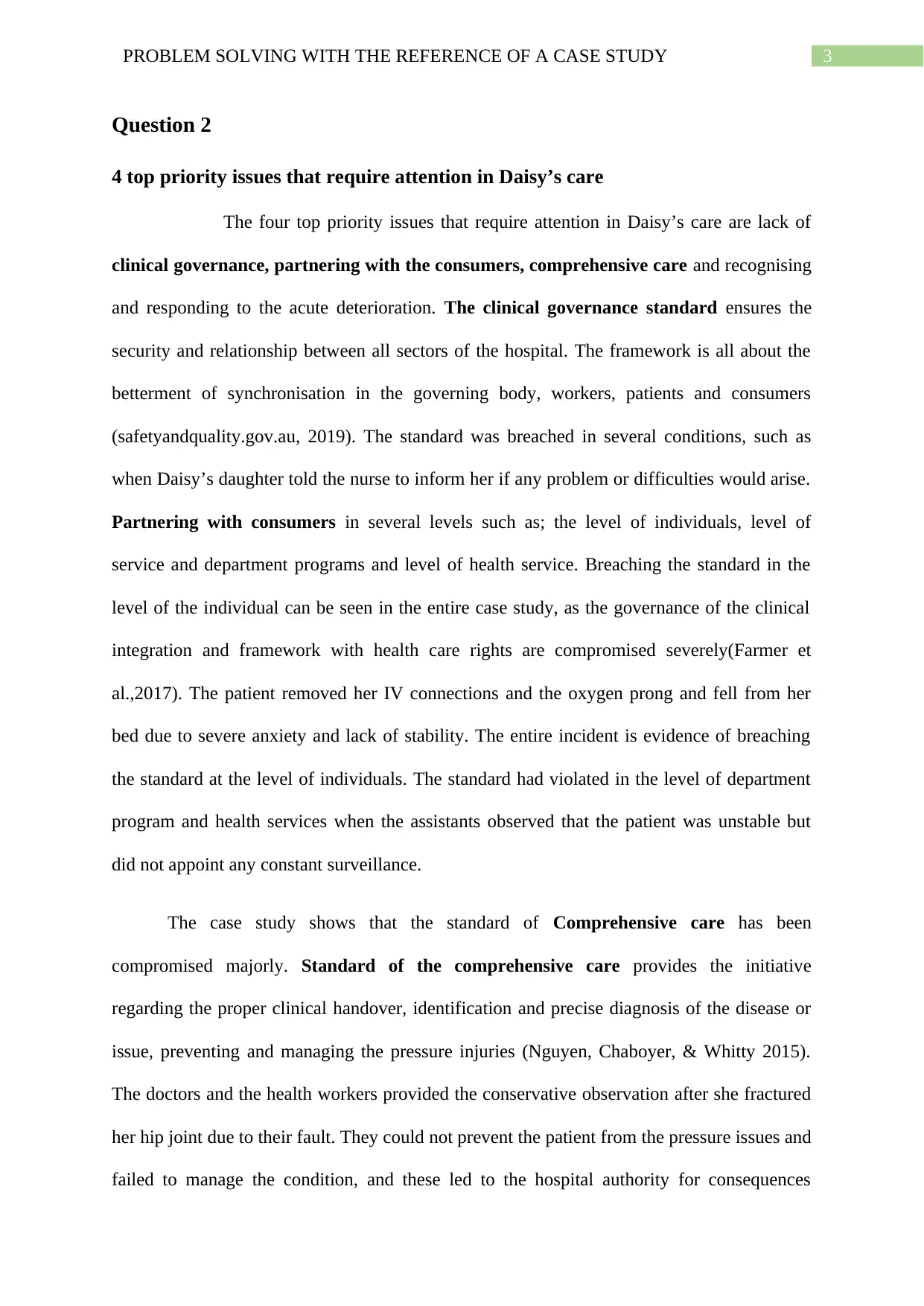
3PROBLEM SOLVING WITH THE REFERENCE OF A CASE STUDY
Question 2
4 top priority issues that require attention in Daisy’s care
The four top priority issues that require attention in Daisy’s care are lack of
clinical governance, partnering with the consumers, comprehensive care and recognising
and responding to the acute deterioration. The clinical governance standard ensures the
security and relationship between all sectors of the hospital. The framework is all about the
betterment of synchronisation in the governing body, workers, patients and consumers
(safetyandquality.gov.au, 2019). The standard was breached in several conditions, such as
when Daisy’s daughter told the nurse to inform her if any problem or difficulties would arise.
Partnering with consumers in several levels such as; the level of individuals, level of
service and department programs and level of health service. Breaching the standard in the
level of the individual can be seen in the entire case study, as the governance of the clinical
integration and framework with health care rights are compromised severely(Farmer et
al.,2017). The patient removed her IV connections and the oxygen prong and fell from her
bed due to severe anxiety and lack of stability. The entire incident is evidence of breaching
the standard at the level of individuals. The standard had violated in the level of department
program and health services when the assistants observed that the patient was unstable but
did not appoint any constant surveillance.
The case study shows that the standard of Comprehensive care has been
compromised majorly. Standard of the comprehensive care provides the initiative
regarding the proper clinical handover, identification and precise diagnosis of the disease or
issue, preventing and managing the pressure injuries (Nguyen, Chaboyer, & Whitty 2015).
The doctors and the health workers provided the conservative observation after she fractured
her hip joint due to their fault. They could not prevent the patient from the pressure issues and
failed to manage the condition, and these led to the hospital authority for consequences
Question 2
4 top priority issues that require attention in Daisy’s care
The four top priority issues that require attention in Daisy’s care are lack of
clinical governance, partnering with the consumers, comprehensive care and recognising
and responding to the acute deterioration. The clinical governance standard ensures the
security and relationship between all sectors of the hospital. The framework is all about the
betterment of synchronisation in the governing body, workers, patients and consumers
(safetyandquality.gov.au, 2019). The standard was breached in several conditions, such as
when Daisy’s daughter told the nurse to inform her if any problem or difficulties would arise.
Partnering with consumers in several levels such as; the level of individuals, level of
service and department programs and level of health service. Breaching the standard in the
level of the individual can be seen in the entire case study, as the governance of the clinical
integration and framework with health care rights are compromised severely(Farmer et
al.,2017). The patient removed her IV connections and the oxygen prong and fell from her
bed due to severe anxiety and lack of stability. The entire incident is evidence of breaching
the standard at the level of individuals. The standard had violated in the level of department
program and health services when the assistants observed that the patient was unstable but
did not appoint any constant surveillance.
The case study shows that the standard of Comprehensive care has been
compromised majorly. Standard of the comprehensive care provides the initiative
regarding the proper clinical handover, identification and precise diagnosis of the disease or
issue, preventing and managing the pressure injuries (Nguyen, Chaboyer, & Whitty 2015).
The doctors and the health workers provided the conservative observation after she fractured
her hip joint due to their fault. They could not prevent the patient from the pressure issues and
failed to manage the condition, and these led to the hospital authority for consequences
Secure Best Marks with AI Grader
Need help grading? Try our AI Grader for instant feedback on your assignments.
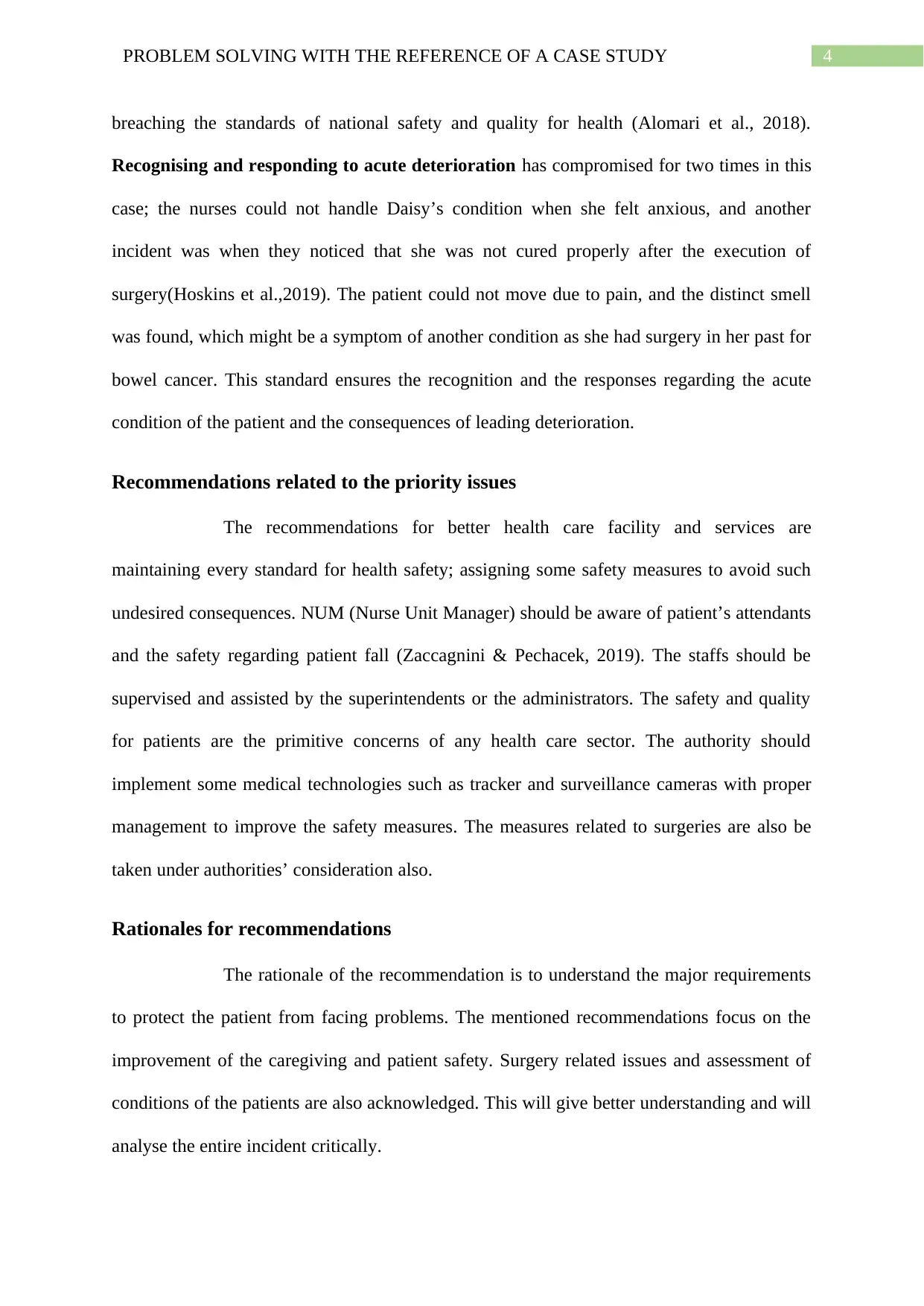
4PROBLEM SOLVING WITH THE REFERENCE OF A CASE STUDY
breaching the standards of national safety and quality for health (Alomari et al., 2018).
Recognising and responding to acute deterioration has compromised for two times in this
case; the nurses could not handle Daisy’s condition when she felt anxious, and another
incident was when they noticed that she was not cured properly after the execution of
surgery(Hoskins et al.,2019). The patient could not move due to pain, and the distinct smell
was found, which might be a symptom of another condition as she had surgery in her past for
bowel cancer. This standard ensures the recognition and the responses regarding the acute
condition of the patient and the consequences of leading deterioration.
Recommendations related to the priority issues
The recommendations for better health care facility and services are
maintaining every standard for health safety; assigning some safety measures to avoid such
undesired consequences. NUM (Nurse Unit Manager) should be aware of patient’s attendants
and the safety regarding patient fall (Zaccagnini & Pechacek, 2019). The staffs should be
supervised and assisted by the superintendents or the administrators. The safety and quality
for patients are the primitive concerns of any health care sector. The authority should
implement some medical technologies such as tracker and surveillance cameras with proper
management to improve the safety measures. The measures related to surgeries are also be
taken under authorities’ consideration also.
Rationales for recommendations
The rationale of the recommendation is to understand the major requirements
to protect the patient from facing problems. The mentioned recommendations focus on the
improvement of the caregiving and patient safety. Surgery related issues and assessment of
conditions of the patients are also acknowledged. This will give better understanding and will
analyse the entire incident critically.
breaching the standards of national safety and quality for health (Alomari et al., 2018).
Recognising and responding to acute deterioration has compromised for two times in this
case; the nurses could not handle Daisy’s condition when she felt anxious, and another
incident was when they noticed that she was not cured properly after the execution of
surgery(Hoskins et al.,2019). The patient could not move due to pain, and the distinct smell
was found, which might be a symptom of another condition as she had surgery in her past for
bowel cancer. This standard ensures the recognition and the responses regarding the acute
condition of the patient and the consequences of leading deterioration.
Recommendations related to the priority issues
The recommendations for better health care facility and services are
maintaining every standard for health safety; assigning some safety measures to avoid such
undesired consequences. NUM (Nurse Unit Manager) should be aware of patient’s attendants
and the safety regarding patient fall (Zaccagnini & Pechacek, 2019). The staffs should be
supervised and assisted by the superintendents or the administrators. The safety and quality
for patients are the primitive concerns of any health care sector. The authority should
implement some medical technologies such as tracker and surveillance cameras with proper
management to improve the safety measures. The measures related to surgeries are also be
taken under authorities’ consideration also.
Rationales for recommendations
The rationale of the recommendation is to understand the major requirements
to protect the patient from facing problems. The mentioned recommendations focus on the
improvement of the caregiving and patient safety. Surgery related issues and assessment of
conditions of the patients are also acknowledged. This will give better understanding and will
analyse the entire incident critically.
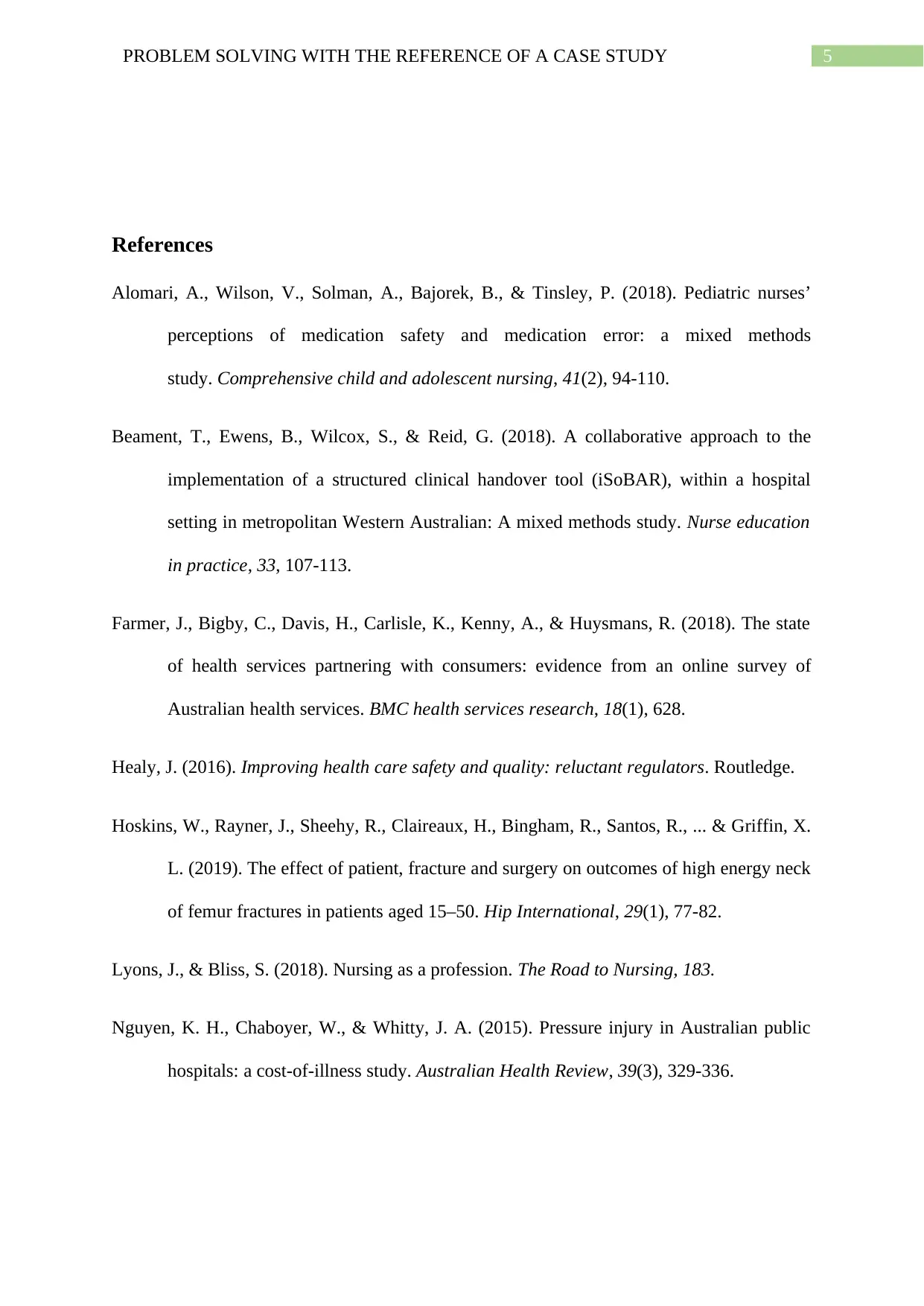
5PROBLEM SOLVING WITH THE REFERENCE OF A CASE STUDY
References
Alomari, A., Wilson, V., Solman, A., Bajorek, B., & Tinsley, P. (2018). Pediatric nurses’
perceptions of medication safety and medication error: a mixed methods
study. Comprehensive child and adolescent nursing, 41(2), 94-110.
Beament, T., Ewens, B., Wilcox, S., & Reid, G. (2018). A collaborative approach to the
implementation of a structured clinical handover tool (iSoBAR), within a hospital
setting in metropolitan Western Australian: A mixed methods study. Nurse education
in practice, 33, 107-113.
Farmer, J., Bigby, C., Davis, H., Carlisle, K., Kenny, A., & Huysmans, R. (2018). The state
of health services partnering with consumers: evidence from an online survey of
Australian health services. BMC health services research, 18(1), 628.
Healy, J. (2016). Improving health care safety and quality: reluctant regulators. Routledge.
Hoskins, W., Rayner, J., Sheehy, R., Claireaux, H., Bingham, R., Santos, R., ... & Griffin, X.
L. (2019). The effect of patient, fracture and surgery on outcomes of high energy neck
of femur fractures in patients aged 15–50. Hip International, 29(1), 77-82.
Lyons, J., & Bliss, S. (2018). Nursing as a profession. The Road to Nursing, 183.
Nguyen, K. H., Chaboyer, W., & Whitty, J. A. (2015). Pressure injury in Australian public
hospitals: a cost-of-illness study. Australian Health Review, 39(3), 329-336.
References
Alomari, A., Wilson, V., Solman, A., Bajorek, B., & Tinsley, P. (2018). Pediatric nurses’
perceptions of medication safety and medication error: a mixed methods
study. Comprehensive child and adolescent nursing, 41(2), 94-110.
Beament, T., Ewens, B., Wilcox, S., & Reid, G. (2018). A collaborative approach to the
implementation of a structured clinical handover tool (iSoBAR), within a hospital
setting in metropolitan Western Australian: A mixed methods study. Nurse education
in practice, 33, 107-113.
Farmer, J., Bigby, C., Davis, H., Carlisle, K., Kenny, A., & Huysmans, R. (2018). The state
of health services partnering with consumers: evidence from an online survey of
Australian health services. BMC health services research, 18(1), 628.
Healy, J. (2016). Improving health care safety and quality: reluctant regulators. Routledge.
Hoskins, W., Rayner, J., Sheehy, R., Claireaux, H., Bingham, R., Santos, R., ... & Griffin, X.
L. (2019). The effect of patient, fracture and surgery on outcomes of high energy neck
of femur fractures in patients aged 15–50. Hip International, 29(1), 77-82.
Lyons, J., & Bliss, S. (2018). Nursing as a profession. The Road to Nursing, 183.
Nguyen, K. H., Chaboyer, W., & Whitty, J. A. (2015). Pressure injury in Australian public
hospitals: a cost-of-illness study. Australian Health Review, 39(3), 329-336.
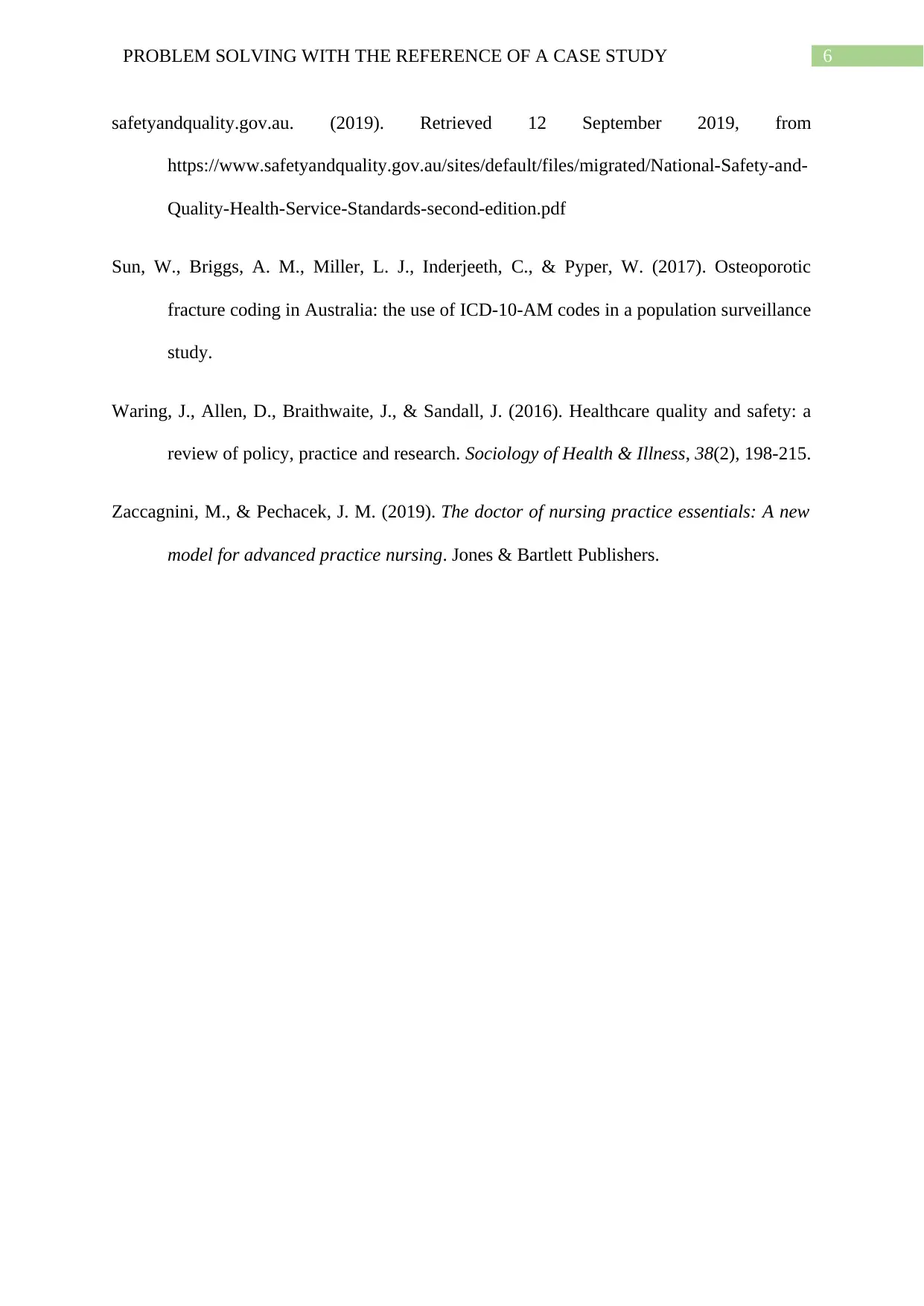
6PROBLEM SOLVING WITH THE REFERENCE OF A CASE STUDY
safetyandquality.gov.au. (2019). Retrieved 12 September 2019, from
https://www.safetyandquality.gov.au/sites/default/files/migrated/National-Safety-and-
Quality-Health-Service-Standards-second-edition.pdf
Sun, W., Briggs, A. M., Miller, L. J., Inderjeeth, C., & Pyper, W. (2017). Osteoporotic
fracture coding in Australia: the use of ICD-10-AM codes in a population surveillance
study.
Waring, J., Allen, D., Braithwaite, J., & Sandall, J. (2016). Healthcare quality and safety: a
review of policy, practice and research. Sociology of Health & Illness, 38(2), 198-215.
Zaccagnini, M., & Pechacek, J. M. (2019). The doctor of nursing practice essentials: A new
model for advanced practice nursing. Jones & Bartlett Publishers.
safetyandquality.gov.au. (2019). Retrieved 12 September 2019, from
https://www.safetyandquality.gov.au/sites/default/files/migrated/National-Safety-and-
Quality-Health-Service-Standards-second-edition.pdf
Sun, W., Briggs, A. M., Miller, L. J., Inderjeeth, C., & Pyper, W. (2017). Osteoporotic
fracture coding in Australia: the use of ICD-10-AM codes in a population surveillance
study.
Waring, J., Allen, D., Braithwaite, J., & Sandall, J. (2016). Healthcare quality and safety: a
review of policy, practice and research. Sociology of Health & Illness, 38(2), 198-215.
Zaccagnini, M., & Pechacek, J. M. (2019). The doctor of nursing practice essentials: A new
model for advanced practice nursing. Jones & Bartlett Publishers.
1 out of 7
Related Documents
Your All-in-One AI-Powered Toolkit for Academic Success.
+13062052269
info@desklib.com
Available 24*7 on WhatsApp / Email
![[object Object]](/_next/static/media/star-bottom.7253800d.svg)
Unlock your academic potential
© 2024 | Zucol Services PVT LTD | All rights reserved.





